July 29, 2024
SINGAPORE – Three metres were all that stood between the existing North-South Line (NSL) tunnels and one point of a 154m-long underground passenger linkway connecting two MRT stations in Orchard.
Connecting the station platforms of the NSL and Thomson-East Coast Line (TEL) in Orchard was only possible with careful planning and delicate construction, as the linkway located right under the existing Orchard NSL station had to eat into the station’s foundation to be built.
Mr Lim Soon Hui, who is the qualified person in charge of this project and the executive director of transport at engineering consultancy Aecom Singapore, noted that the project spanned about eight years – two of which were for preliminary design development.
From February 2014 to June 2022, engineers and workers had to ensure that trains on the NSL continued to run smoothly above the construction site by doing frequent checks to ensure that the NSL tunnels and station moved only marginally, within a certain safety threshold.
First, the team installed an inverted U-shaped roof canopy made of interlocking steel pipes and frames – by inserting these horizontal pipes underground one by one – under the surface of Orchard Boulevard, to make way for the underpass below the canopy.
The weight of Orchard Boulevard was supported by the 40m-long canopy, which draws on the strength of the interlocking pipes to prevent the surface from caving in due to the load.
The roof canopy also removed the need to cut the road up at street level to build the linkway, which would have disrupted road traffic and MRT operations. With the steel pipes and frames in place, the tunnel could be dug from underground without any drastic soil movement taking place.
Mr Lim said: “We did not dig Orchard Boulevard (up) partly because it is very deep, and also because it would cause the existing NSL tunnels to move… So we had no choice but to use this method.”
The Building and Construction Authority (BCA) said on July 28 that Mr Lim will be awarded the BCA Design and Engineering Safety Award in September for his work on this project.
This was the first time in Singapore that a retractable micro-tunnel boring machine – a device to tunnel through the ground horizontally to install pipes one at a time from one end to another – was used for the installation of interlocking pipes, added Mr Lim.
Located just 30m below Orchard Boulevard, this section of the underpass spanning around 52m in length took around 1½ years to be constructed.
Next, alternative supporting structures had to be built underground, as some of the original foundation piles of the Orchard NSL station and platform needed to be cut to make way for the linkway. Piles are tall cylindrical columns drilled into the ground to support a structure.
Horizontal beams, new mini piles and concrete wall structures were constructed to transfer the weight of the Orchard NSL station and platform away from its initial set of piles.
Since this 102m-long section was located just below the existing Orchard NSL station and platform with trains moving in and out actively, the cutting process had to be done delicately and progressively over a period of almost five years.
Mr Lim noted that there are risks of disruptions to train operations if the piles sink during construction or if the alternative supporting structures cannot withstand the load.
The Orchard TEL station opened in November 2022 as one of the 11 stations in the third stage of the TEL, which runs from Stevens station to Gardens by the Bay station.
Mr Lim is among six recipients of the BCA Design and Engineering Safety Award in 2024. The other winners include Mr Aaron Foong for his work on residential development Riviere in Havelock, and Mr Yiong Hoi Liong for his contributions to commercial project CapitaSky at the site of the former Central Provident Fund (CPF) building in Tanjong Pagar.
For Riviere, Mr Foong, managing director of engineering company KTP Consultants, and his team came up with a unique circular earth-retaining structure to carry out excavation works for a three-level basement, as it prevents the corners from buckling under due to unbalanced soil pressure near the Singapore River.
The team also facilitated the conservation of heritage buildings, previously occupied by Zouk, by testing the structural integrity of new components, while maintaining historical architectural elements.
In CapitaSky’s case, Mr Yiong, director of architectural and engineering consultancy P&T Consultants, and his team reused all 186 existing piles from the former CPF building and installed 42 new piles in the new building.
It was a challenge to reuse the existing piles, as the team had to check their specifications against documents from half a decade ago and run multiple stress tests to ensure that the load of the redevelopment could be withstood by the piles.
This was to minimise potential disturbances to MRT operations and railway tunnels, as the original basement wall was situated less than 6m from the East-West Line MRT tunnels.
The office building is also the first commercial redevelopment project in the Central Business District to reuse all of its original piles.

